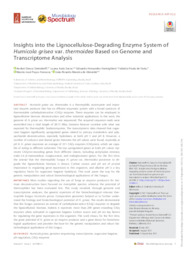Insights into the Lignocellulose-Degrading Enzyme System of Humicola grisea var. thermoidea Based on Genome and Transcriptome Analysis.
Insights into the Lignocellulose-Degrading Enzyme System of Humicola grisea var. thermoidea Based on Genome and Transcriptome Analysis.
Author(s): STEINDORFF, A. S.; SERRA, L. A.; FORMIGHIERI, E. F.; FARIA, F. P. de; POÇAS-FONSECA, M. J.; ALMEIDA, J. R. M. de
Summary: Abstract: Humicola grisea var. thermoidea is a thermophilic ascomycete and important enzyme producer that has an efficient enzymatic system with a broad spectrum of thermostable carbohydrate-active (CAZy) enzymes. These enzymes can be employed in lignocellulose biomass deconstruction and other industrial applications. In this work, the genome of H. grisea var. thermoidea was sequenced. The acquired sequence reads were assembled into a total length of 28.75 Mbp. Genome features correlate with what was expected for thermophilic Sordariomycetes. The transcriptomic data showed that sugar-cane bagasse significantly upregulated genes related to primary metabolism and polysaccharide deconstruction, especially hydrolases, at both pH 5 and pH 8. However, a number of exclusive and shared genes between the pH values were found, especially at pH 8. H. grisea expresses an average of 211 CAZy enzymes (CAZymes), which are capable of acting in different substrates. The top upregulated genes at both pH values represent CAZyme-encoding genes from different classes, including acetylxylan esterase, endo-1,4-b-mannosidase, exoglucanase, and endoglucanase genes. For the first time, the arsenal that the thermophilic fungus H. grisea var. thermoidea possesses to degrade the lignocellulosic biomass is shown. Carbon source and pH are of pivotal importance in regulating gene expression in this organism, and alkaline pH is a key regulatory factor for sugarcane bagasse hydrolysis. This work paves the way for the genetic manipulation and robust biotechnological applications of this fungus.
Publication year: 2021
Types of publication: Journal article
Unit: Embrapa Agroenergy
Observation
Some of Embrapa's publications are published as ePub files. To read them, use or download one of the following free software options to your computer or mobile device. Android: Google Play Books; IOS: iBooks; Windows and Linux: Calibre.
Access other publications
Access the Agricultural Research Database (BDPA) to consult Embrapa's full library collection and records.
Visit Embrapa Bookstore to purchase books and other publications sold by Embrapa.

